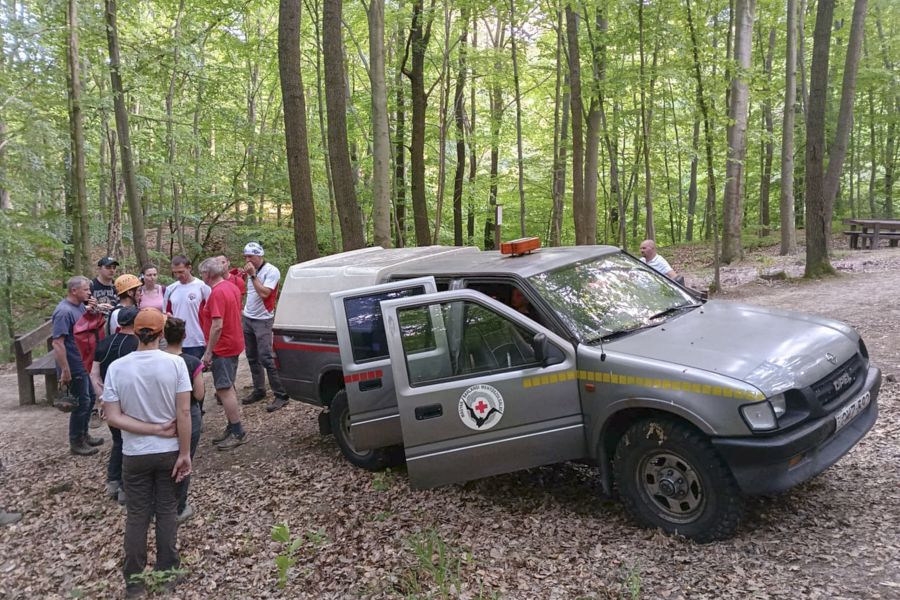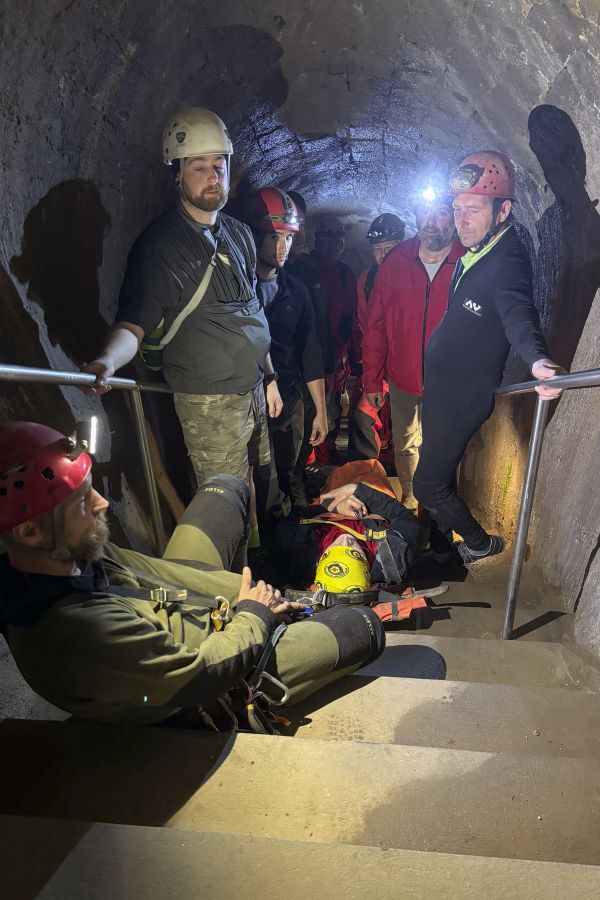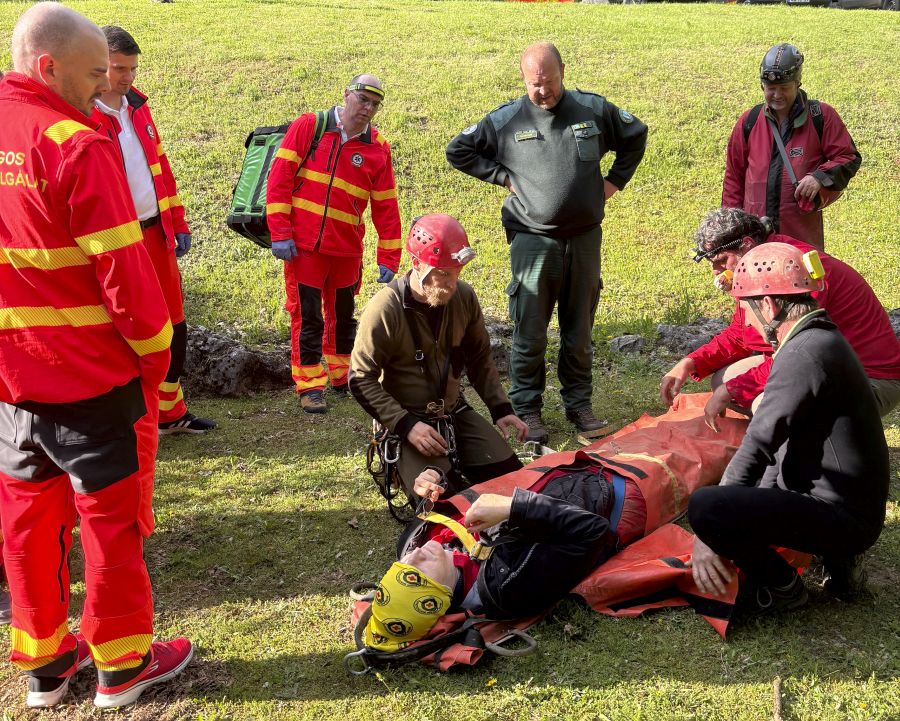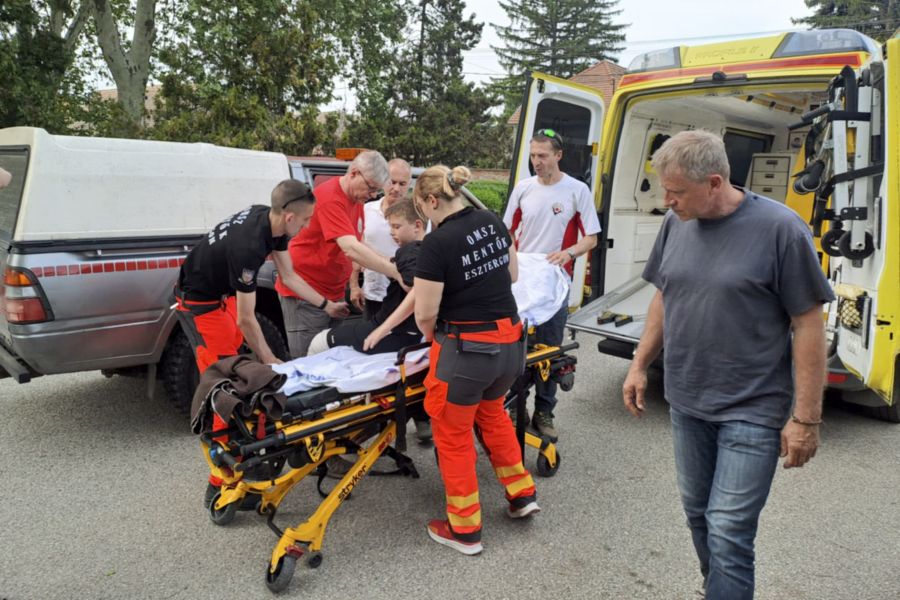 After last week’s Earth Day demo, we tried to look into the future with our newly joined cave rescue teammate — wondering whether the BMSz would be needed over the upcoming long weekend. As it turned out, yes — and more than once.
After last week’s Earth Day demo, we tried to look into the future with our newly joined cave rescue teammate — wondering whether the BMSz would be needed over the upcoming long weekend. As it turned out, yes — and more than once.
The long weekend began on Wednesday afternoon. A distress call came from near Vértesszőlős: a paraglider had landed in a tree, not too far from the site where a rescue operation turnded fatal few years before. This time, the help didn’t arrive with a military helicopter, but in the form of a volunteer from the Tree Rescue Group coordinated by BMSz – a team made up of rope access experts, arborists, and cave rescuers. The pilot was swaying about 7–8 meters above the ground and was lucky to be uninjured – but it was unfortunate that due to dry branches, it wasn’t possible to climb above him or build an anchor point for hoisting or lowering. To bring him down safely, a diagonally hauling system was rigged to secure him toward the trunk, and a few thicker dry branches had to be cut to free him. It took about 30 minutes to lower the pilot, and three times as long to retrieve the canopy.
On May 1st, one of our cave rescuers was heading to the Tatabánya via ferrata with a fellow caver. Upon arrival, they found police officers and members of the Tatabánya 4x4 Civil Protection and Volunteer Firefighters Association gathering at the Turul Monument parking area to search for a missing child. Our team member not only knows well the via ferrata routes, but he was also deeply familiar with the area, having explored local caves since the 1980s. The child had disappeared from his family at the Ranzinger Lookout Tower, and they were unable to find him on their own. Quick thinking, a mental map, estimating time since disappearance, and narrowing down possible hiking trails led to three potential search directions. Hikers on the first two paths had not seen the teenager, so the search continued on third one, the red circle trail toward the spring. That’s where the team finally encountered the exhausted and slightly dehydrated boy, who was then transported by off-road vehicle back to the Turul parking lot – to everyone's relief. Once again, our frequently repeated point was proven true: the detailed local knowledge of cavers and cave rescuers is a huge asset in such search and rescue operations.

Many of our cave rescuers were teaching rigging and rescue techniques for cavers on a week long workshop. The two closest veteran rescuers received the call while at the Denevér Wall, near the entrance of the Baradla Cave in Aggtelek. They quickly made their way to the other, Vörös-tó entrance, where they met up with arriving paramedics from the National Ambulance Service and headed into the cave together.
They found the patient in the main passage with the tour guide – in relatively good condition. After examination they decided the injured person should be transported on a specialized cave rescue stretcher with assistance from rescuers, caveing students, and staff from the National Park and ranger service. The 20-story ascent was completed fairly quickly, and about an hour after the initial alert, the patient was transferred to an ambulance for further care in an Emergency Center in a near hospital.
Until early Saturday afternoon, we thought our “hat-trick” would be the end of the long weekend. That belief held until 3 PM, when our emergency line rang again: a hiker had injured their knee in the Rám-szakadék. Even in summer-like weather, this gorge is a challenging terrain, so we launched the mission with a team of 14 and a doctor and serious gear. We prepared to tackle the trail either up or down – including difficult sections that are hard to pass even without a stretcher. Fortunately, the 10-year-old boy had slipped and injured himself just above the truly hazardous sections, in a relatively manageable area.
The off-road vehicle carrying our rescue equipment reached the rest area above the gorge, where we found the injured boy and his concerned parents. Our cave rescue doctor examined him and stabilized the knee in a position that caused the least pain. The rescue vehicle then transformed into a patient transport "taxi" and delivered the boy and his family to the ambulance waiting in a village nearby. He was taken to the hospital in Esztergom, where the doctor’s preliminary diagnosis was confirmed: a serious injury happened.
At the request of the Pilis Park Forest, which manages the area, BMSz developed a detailed rescue plan for this year, offering a practical guide to professional or volunteer rescuers responding to accidents in the gorge of Rám-szakadék. The plan aids even those trainded rescuers who are unfamiliar with the certain area. It gives also clear guidance on equipment and personnel needs for patient movement in different sections of the gorge, and provides other immediately useful advice for rescue coordinators and participants. With this plan, BMSz aims to strengthen the safety net for the roughly 60,000 tourists who visit the area each year.
On Sunday, the last day of the four-day weekend, one of our members once again headed to Tatabánya to finally enjoy a peaceful via ferrata trip after several interrupted attempts in recent days. Unsurprisingly, that didn’t go entirely as planned either – a climber ahead of him fell into his long safety lanyard, didn’t reach the end of it, making it impossible to climb back up on their own. Our colleague improvised a counterbalance system and hoisted the stranded climber back onto safe path.
We are often asked: now as outdoor, climbing, and caving gears are safer than ever, caver training is effective, and the strict regulations of national parks have nearly eliminated caving accidents – why to maintain a cave rescue service that carries out just a few rescues in a year? Our answer is always the same: we are rarely needed – but when we are, we are veryneeded. There are remote, hard-to-reach locations where hikers, cavers, or now even paragliders can get into trouble – places where only cave rescuers are equipped to help effectively. That’s exactly what BMSz has been preparing for and working toward for 64 years.
With our team of 100 volunteers, extensive underground and surface knowledge, doctors who can reach the most inaccessible locations, and methods honed over decades, we shoulder a special responsibility to protect those in trouble underground or in challenging natural environments.




